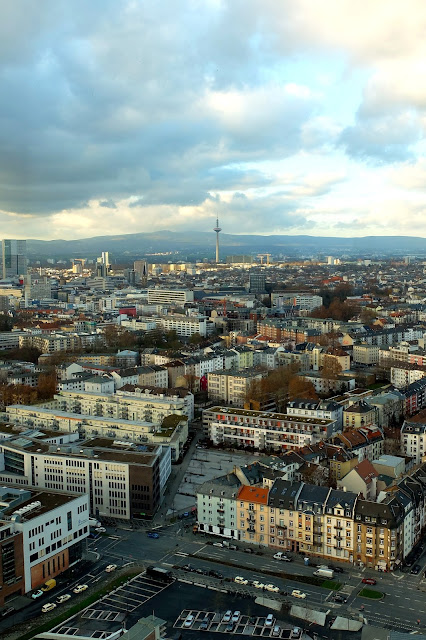There was no time to waste. 3 days in Berlin was going to fly by so we were determined to make the most of it. Of course our primary mission was to secure a flat for our return in January. Now seasoned apartment hunters after our run-around in Frankfurt, Fritz had a meeting already lined up with a lovely couple in their rather swanky flat in West Berlin. I'll save the details on our future apartment for our return since most of our 3-day adventure consisted of seeing the Berlin sights.
Berlin was loaded with Christmas markets.
One of the more famous markets was right in front of this famous church. The Kaiser Wilhelm Memorial Church was built in the 1890s. It was badly damaged in a bombing raid during World War II and if you walk around the side of it, you can see gaping holes that were torn through the side of the structure as well as its damaged spire. Although newer buildings have been built on either side of the church which are used for worship, the original building was not repaired as a reminder of the horrible events of WWII and the futility of war.
Another lovely Christams Market was right in front of the Charlottenburg Palace.
We were too busy eating sausages to try the smoked fish, but these fish fires were another neat part of almost every Christmas Market.
We had lovely weather to hit all the major tourist spots. Behind me is the Reichstag building, which is the meeting place for the German parliament.
The Brandenburg Gate was built in 1791 by the Kind of Prussia as a sign of peace. During the Cold War, the Berlin Wall stood right next to it, and this spot was featured in media coverage from when the Wall was torn down in 1989.
There are parts of the city that still contain sections of the Berlin Wall.
Other spots feature a strip embedded in the pavement marking the place where the former wall stood.
The Holocaust Memorial, also called The Memorial to the Murdered Jews of Europe, stretches out over 4 acres with concrete slabs ranging in heights from 8 inches to 15 feet. The ground on which the slabs are placed slopes so when you are standing on the outside of the memorial looking in, they all appear to be of a similar height, but as you walk deeper into the slabs, you find the concrete masses towering over you.
Peter Eisenman, the designer and architect, intended for the structure to produce an uneasy, confusing atmosphere. The whole sculpture aims to represent a supposedly ordered system that has lost touch with human reason. The memorial also bears a resemblance to a cemetery. The slabs are covered with a graffiti-resistant coating to prevent neo-Nazis from painting swastikas on the sculpture, which happened 5 times in the first year before the special coating was added.
These two cuties were hanging out by the Brandenburg Gate.
We had to visit Checkpoint Charlie, one of the most iconic spots in Berlin. This was the best-known Berlin Wall crossing point between East Berlin, the capital of communist East Germany, and West Berlin, part of West Germany, during the Cold War. The checkpoint was manned by US troops. It's called Checkpoint "Charlie" because the checkpoints were labeled alphabetically. There was also a Checkpoint A and B or "Alfa" and "Bravo". Using the International Radiotelephony Spelling Alphabet, C is called "Charlie."
Today Checkpoint Charlie is pretty much a big old tourist trap. People take turns standing next to this German guy dressed as an American soldier. My biggest question is, how long did it take for them to install a McDonalds right behind Checkpoint Charlie after the Berlin Wall fell?






































































